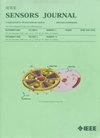用于锂电池实时热监测的Er³+/Yb³+共掺碲酸盐光纤温度传感器
IF 4.3
2区 综合性期刊
Q1 ENGINEERING, ELECTRICAL & ELECTRONIC
引用次数: 0
摘要
我们提出并通过实验证明了一种基于非热耦合电平(NTCL)荧光强度比(FIR)的非接触式光学测温研究,可用于锂电池的实时温度检测。采用传统的熔淬法制备了无芯 Er3+/Yb3+ 共掺杂 TeO2-Al2 O3-WO3-BaF2 + Er2O3 + Yb2O3 (TWA) 光纤,并详细研究了 Al2O3 浓度对光纤发光的影响。同时,比较了基于热耦合电平(TCL)的 FIR 温度解调方法。结果发现,利用基于 NTCL 的 FIR 方法,传感器的灵敏度至少提高了十倍,在 Al2O3 浓度为 4 mol% 时,传感器的传感性能最佳,在 258-371 K 的温度范围内,传感器的传感性能为 10^{-{4}}$ K-1 的 434.3 倍。此外,该传感器还具有较高的温度分辨率和良好的重复性,在对 18650 型锂电池充放电过程进行热监测时,其最大测量误差仅为 0.7 K。据我们所知,这是第一份使用基于 FIR 的温度传感器对 18650 型锂电池进行实时监测的报告。所提出的传感器具有出色的稳定性和可重复性、抗电磁干扰和抗腐蚀能力,以及避免交叉敏感的能力。它为新能源电池应用中的远距离实时温度监测提供了有效可靠的测量解决方案。本文章由计算机程序翻译,如有差异,请以英文原文为准。
An Er³+/Yb³+ Co-Doped Tellurite Fiber Temperature Sensor for Real-Time Thermal Monitoring for Lithium Battery
We propose and experimentally demonstrate a noncontact optical thermometric study based on fluorescence intensity ratio (FIR) of nonthermally coupled levels (NTCLs) for real-time temperature detection of lithium batteries. The no-core Er3+/Yb3+ co-doped TeO2–Al2 O3–WO3–BaF2 + Er2O3 + Yb2O3 (TWA) optical fiber was prepared using the traditional melt-quenching method, and influence of the Al2O3 concentration on the fiber luminescence was investigated in detail. Meanwhile, temperature demodulation by means of thermally coupled level (TCL)-based FIR was juxtaposed for comparison. It was found that the sensor’s sensitivity was enhanced at least ten times utilizing the NTCL-based FIR method, and at an Al2O3 concentration of 4 mol%, the sensor demonstrated the best sensing performance, which was $434.3\times 10^{-{4}}$ K−1 in the temperature range of 258–371 K. In addition, this sensor had high-temperature resolution and good repeatability, and its maximum measurement error during thermal monitoring of the charging/ discharging process of an 18650-type lithium battery was only 0.7 K. To the best of our knowledge, this was the first report to use a temperature sensor based on FIR for real-time monitoring of 18650-type lithium batteries. The proposed sensor demonstrated excellent stability and repeatability, resistance to electromagnetic interference and corrosion, and the capability to avoid cross-sensitivity. It provides an effective and reliable measurement solution for long-distance and real-time temperature monitoring in new energy battery applications.
求助全文
通过发布文献求助,成功后即可免费获取论文全文。
去求助
来源期刊

IEEE Sensors Journal
工程技术-工程:电子与电气
CiteScore
7.70
自引率
14.00%
发文量
2058
审稿时长
5.2 months
期刊介绍:
The fields of interest of the IEEE Sensors Journal are the theory, design , fabrication, manufacturing and applications of devices for sensing and transducing physical, chemical and biological phenomena, with emphasis on the electronics and physics aspect of sensors and integrated sensors-actuators. IEEE Sensors Journal deals with the following:
-Sensor Phenomenology, Modelling, and Evaluation
-Sensor Materials, Processing, and Fabrication
-Chemical and Gas Sensors
-Microfluidics and Biosensors
-Optical Sensors
-Physical Sensors: Temperature, Mechanical, Magnetic, and others
-Acoustic and Ultrasonic Sensors
-Sensor Packaging
-Sensor Networks
-Sensor Applications
-Sensor Systems: Signals, Processing, and Interfaces
-Actuators and Sensor Power Systems
-Sensor Signal Processing for high precision and stability (amplification, filtering, linearization, modulation/demodulation) and under harsh conditions (EMC, radiation, humidity, temperature); energy consumption/harvesting
-Sensor Data Processing (soft computing with sensor data, e.g., pattern recognition, machine learning, evolutionary computation; sensor data fusion, processing of wave e.g., electromagnetic and acoustic; and non-wave, e.g., chemical, gravity, particle, thermal, radiative and non-radiative sensor data, detection, estimation and classification based on sensor data)
-Sensors in Industrial Practice
 求助内容:
求助内容: 应助结果提醒方式:
应助结果提醒方式:


